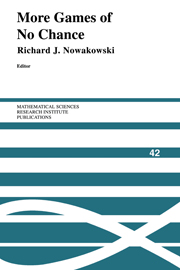Book contents
- Frontmatter
- Contents
- Preface
- The Big Picture
- Idempotents Among Partisan Games
- On the Lattice Structure of Finite Games
- More Infinite Games
- Alpha-Beta Pruning Under Partial Orders
- The Abstract Structure of the Group of Games
- The Old Classics
- Higher Nimbers in Pawn Endgames on Large Chessboards
- Restoring Fairness to Dukego
- Go Thermography: The 4/21/98 Jiang-Rui Endgame
- An Application of Mathematical Game Theory to Go Endgames: Some Width-Two-Entrance Rooms With and Without Kos
- Go Endgames Are PSPACE-Hard
- Global Threats in Combinatorial Games: A Computation Model with Applications to Chess Endgames
- The Game of Hex: The Hierarchical Approach
- Hypercube Tic-Tac-Toe
- Transfinite Chomp
- A Memory Efficient Retrograde Algorithm and Its Application to Chinese Chess Endgames
- The New Classics
- The 4G4G4G4G4 Problems and Solutions
- Experiments in Computer Amazons
- Exhaustive Search in Amazons
- Two-Player Games on Cellular Automata
- Who Wins Domineering on Rectangular Boards?
- Forcing Your Opponent to Stay in Control of a Loony Dot-and-Boxes Endgame
- 1 x n Konane: A Summary of Results
- 1-Dimensional Peg Solitaire, and Duotaire
- Phutball Endgames Are Hard
- One-Dimensional Phutball
- A Symmetric Strategy in Graph Avoidance Games
- A Simple FSM-Based Proof of the Additive Periodicity of the Sprague-Grundy Function of Wythoff's Game
- Puzzles and Life
- The Complexity of Clickomania
- Coin-Moving Puzzles
- Searching for Spaceships
- Surveys
- Unsolved Problems in Combinatorial Game Theory: Updated
- Combinatorial Games: Selected Bibliography With A Succinct Gourmet Introduction
Preface
Published online by Cambridge University Press: 29 May 2025
- Frontmatter
- Contents
- Preface
- The Big Picture
- Idempotents Among Partisan Games
- On the Lattice Structure of Finite Games
- More Infinite Games
- Alpha-Beta Pruning Under Partial Orders
- The Abstract Structure of the Group of Games
- The Old Classics
- Higher Nimbers in Pawn Endgames on Large Chessboards
- Restoring Fairness to Dukego
- Go Thermography: The 4/21/98 Jiang-Rui Endgame
- An Application of Mathematical Game Theory to Go Endgames: Some Width-Two-Entrance Rooms With and Without Kos
- Go Endgames Are PSPACE-Hard
- Global Threats in Combinatorial Games: A Computation Model with Applications to Chess Endgames
- The Game of Hex: The Hierarchical Approach
- Hypercube Tic-Tac-Toe
- Transfinite Chomp
- A Memory Efficient Retrograde Algorithm and Its Application to Chinese Chess Endgames
- The New Classics
- The 4G4G4G4G4 Problems and Solutions
- Experiments in Computer Amazons
- Exhaustive Search in Amazons
- Two-Player Games on Cellular Automata
- Who Wins Domineering on Rectangular Boards?
- Forcing Your Opponent to Stay in Control of a Loony Dot-and-Boxes Endgame
- 1 x n Konane: A Summary of Results
- 1-Dimensional Peg Solitaire, and Duotaire
- Phutball Endgames Are Hard
- One-Dimensional Phutball
- A Symmetric Strategy in Graph Avoidance Games
- A Simple FSM-Based Proof of the Additive Periodicity of the Sprague-Grundy Function of Wythoff's Game
- Puzzles and Life
- The Complexity of Clickomania
- Coin-Moving Puzzles
- Searching for Spaceships
- Surveys
- Unsolved Problems in Combinatorial Game Theory: Updated
- Combinatorial Games: Selected Bibliography With A Succinct Gourmet Introduction
Summary
This volume arose from the second Combinatorial Games Theory Workshop and Conference, held at MSRI from July 24 to 28, 2000. The first such conference at MSRI, which took place in 1994, gave a boost to the relatively new field of Combinatorial Game Theory (CGT); its excitement is captured in Games of No Chance (Cambridge University Press, 1996), which includes an introduction to CGT and a brief history of the subject. In this volume we pick up where Games of No Chance left off.
Although Game Theory overlaps many disciplines, the majority of the researchers are in mathematics and computer science. This was the first time that the practioners from both camps were brought together deliberately, and the results are impressive. This bringing together seems to have formed a critical mass. There has already been a follow-up workshop at Dagstuhl (February 2002) and more are planned.
This conference greatly expanded upon the accomplishments of and questions posed at the first conference. What is missing from this volume are the reports of games that were played and analyzed at the conference; of Grossman's Dotsand- Boxes program beating everyone in sight, except for the top four humans who had it beat by the fifth move.
This volume is divided into five parts. The first deals with new theoretical developments. Calistrate, Paulhus, and Wolfe correct a mistake about the ordering of the set of game values, a mistake that has been around for three decades or more. Not only do they show that the ordering is much richer than previously thought, they open up a whole new avenue of investigations. Conway echoes this theme of fantastic and weird structures in CGT (2 being the cube root of), and he introduces the smallest infinite games.
The classical games are well represented. Elkies continues his investigations in Chess. There are many new results and tantalizing hints about the deep structure of Go. Moore and Eppstein turn one-dimensional solitaire into a twoplayer game, and conjecture that the S—values are unbounded. (In attempting to solve this, Albert, Grossman and Nowakowski defined Clobber, a big hit at the Dagstuhl conference.)
Information
- Type
- Chapter
- Information
- More Games of No Chance , pp. xi - xiiPublisher: Cambridge University PressPrint publication year: 2002
